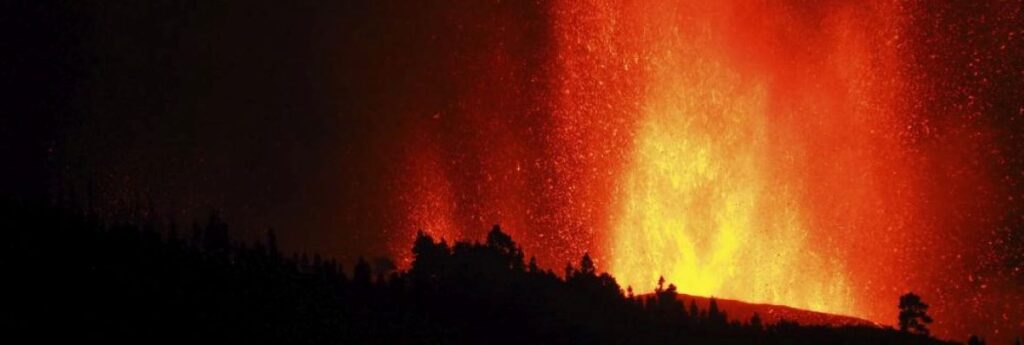Giant rivers of lava tumbled slowly but relentlessly toward the sea in Palma Monday after a volcano erupted in Spain’s Canary Islands, destroying everything in their path. Prompt evacuations of residents helped avoid casualties.
The eruption occurred Sunday on the island off the coast of Africa along a ridge called Cumbre Vieja, where two fissures belched bright red magma into the air and set the glowing lava rivers in motion.
Scientists had been monitoring the area in recent days amid a surge in mostly small earthquakes, and authorities evacuated around 5,000 people.
The lava was moving at 700 metres per hour, according to the Canary Islands Volcanology Institute.
The lava left black swathes of destruction through the sparsely populated, green countryside and destroyed around 100 houses, officials said.
Authorities told people in areas where volcanic ash was falling to stay indoors with their doors and windows closed.
The lava crept into the town of Los Llanos de Aridane, which lies close to the volcano. Town Mayor Noelia García said people had been evacuated from houses all the way down to the shoreline.
Mariano Hernández, head of the island’s government, described the scene in the area affected by the lava as “bleak.”
He said a wall of lava six metres high “is consuming houses, infrastructure, crops, in its path to the coast,” state news agency Efe reported.
Scientists monitoring the lava measured it at more than 1,000 degrees C with explosions and clouds of acidic steam in store when it hit the Atlantic Ocean. Merchant shipping was halted around La Palma.
Scientists say the lava flows could last for weeks or months, but the immediate danger to local people appeared to be over.
Daniel Álvarez, a bar owner in Las Manchas, one of the closest villages to the volcano, was evacuated with his family on Sunday and was staying at the El Fuerte military barracks with some other 300 evacuees. He didn’t know whether the lava had consumed his home.
“For now,” he said, “it seems like it’s safe, but the lava is opening many paths. We have all of our lives inside (our house). We would need to start over again.”
Canary Islands government chief Ángel Víctor Torres said officials weren’t expecting any more eruptions, adding that air traffic in the area wasn’t affected.
“There will be considerable material damage,” Torres said. “We hope there won’t be any personal injuries.”
No further evacuations were expected, officials said.
“The lava probably won’t take any lives, but it will destroy everything it encounters,” Nemesio Pérez, scientific coordinator at the Canary Islands Volcanology Institute, stated.
The eruption opened two fissures, about 200 metres apart. Officials said the lava streams would likely merge before reaching the sea.
The Military Emergencies Unit was increasing its deployment on La Palma to 180 soldiers and 57 vehicles, backed up with three water-dropping aircraft due to arrive later Monday.
People on La Palma largely live from farming.
Spanish Prime Minister Pedro Sánchez visited the affected area Monday after cancelling his trip to New York to attend the UN General Assembly. He praised scientists for monitoring the eruption, saying their work was “fundamental” in avoiding casualties, and promised that his government would help local people rebuild their lives.
The Canary Islands Volcanology Institute reported the initial eruption shortly after 3 p.m. Sunday near the southern end of the island, which saw its last eruption in 1971.
A 4.2-magnitude quake was recorded before the eruption, which took place in an area known as Cabeza de Vaca on the western slope as the ridge descends to the coast.
Huge red plumes topped with black-and-white smoke shot out along the Cumbre Vieja ridge, which scientists had been monitoring following the accumulation of molten lava below the surface and days of small earthquakes.
La Palma, with a population of 85,000, is one of eight volcanic islands in Spain’s Canary Islands archipelago off Africa’s western coast. At their nearest point, the islands are 100 km. from Morocco.
The last eruption on La Palma 50 years ago lasted just over three weeks. The last eruption on all the Canary Islands occurred underwater off the coast of El Hierro island in 2011. It lasted five months.

